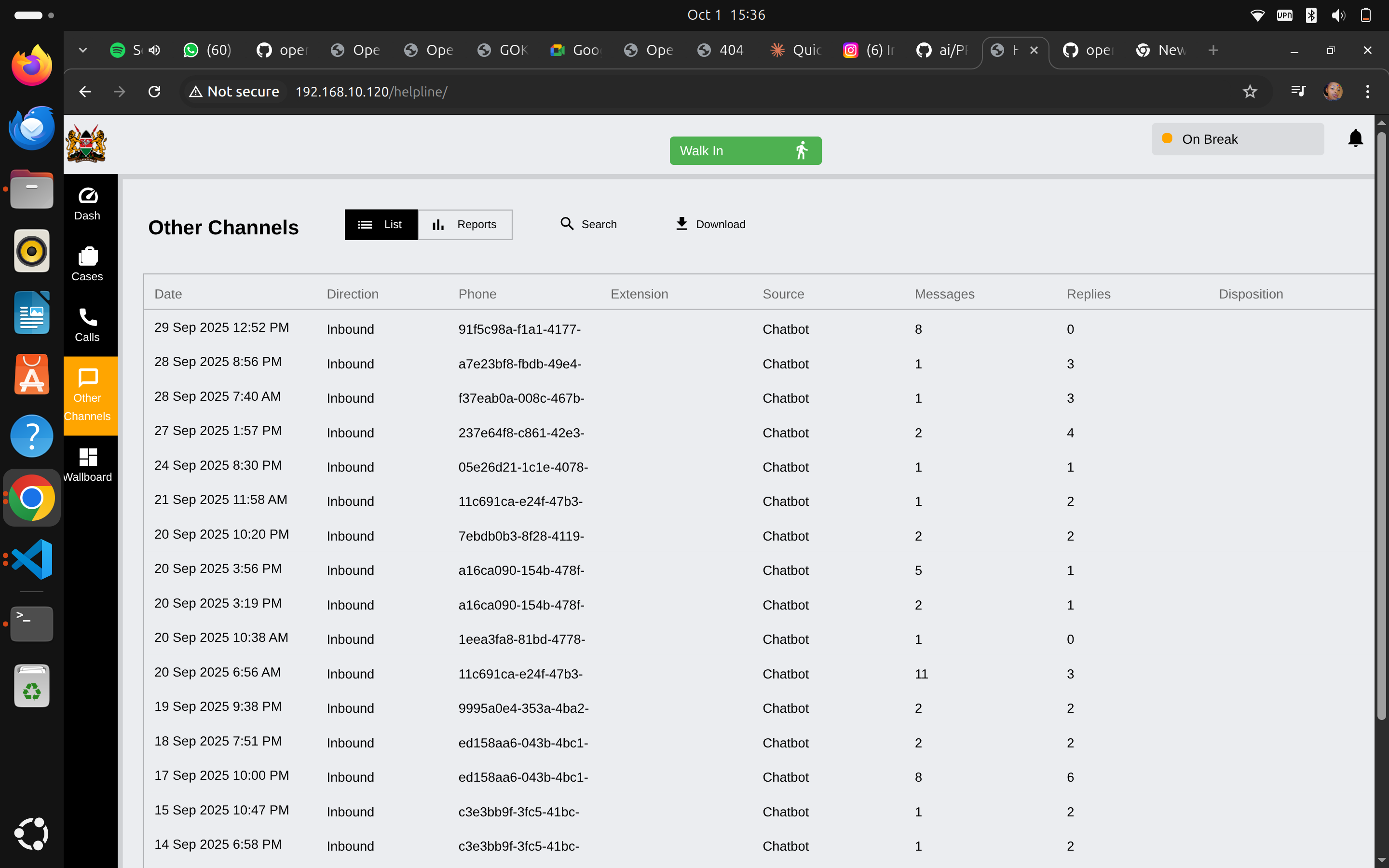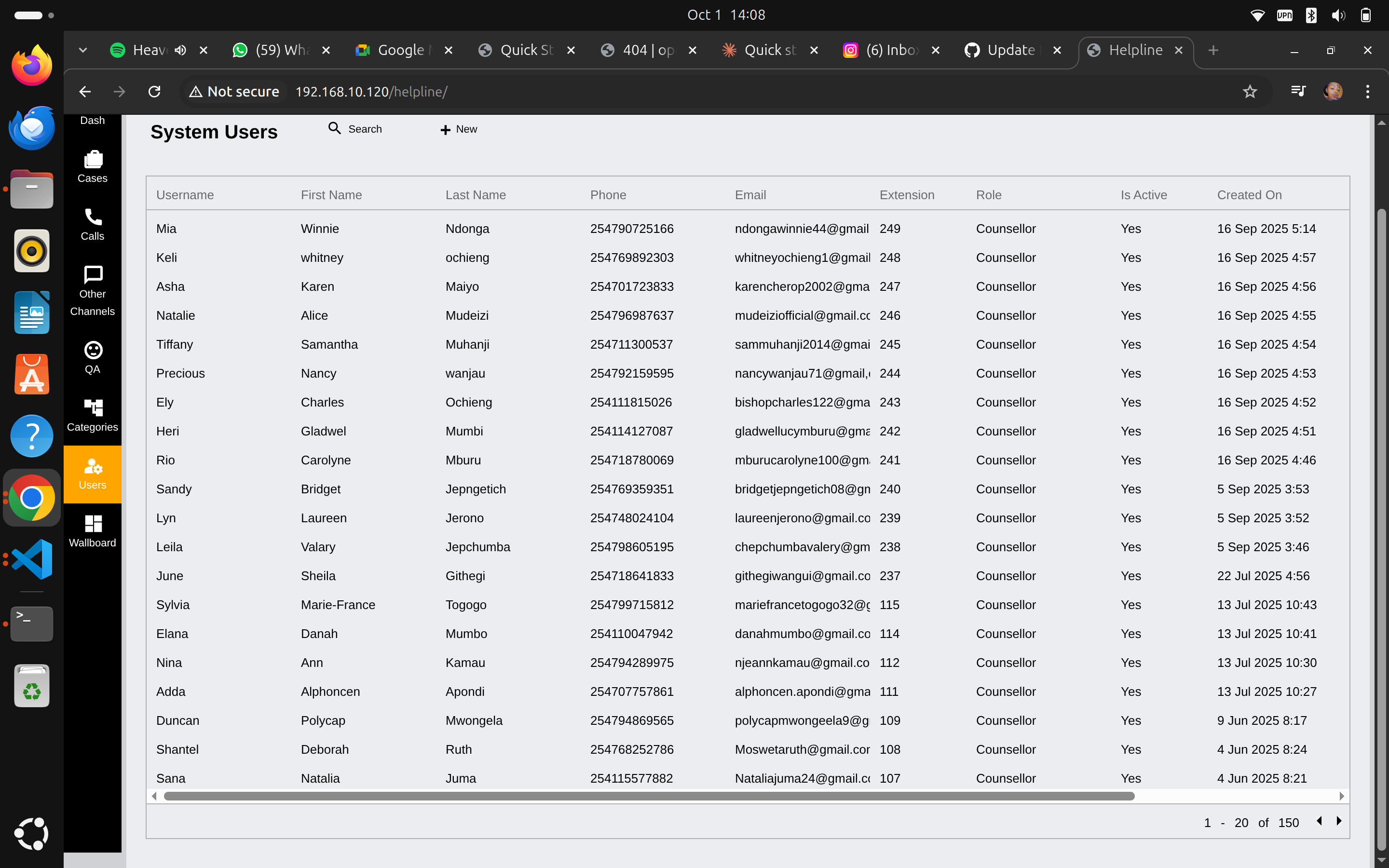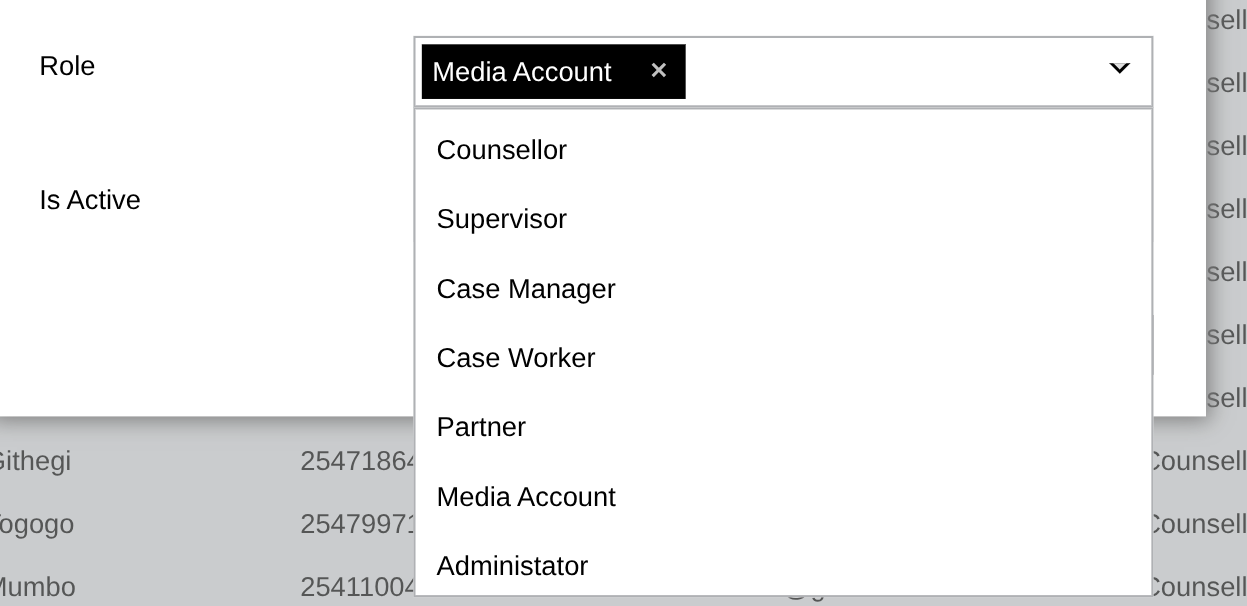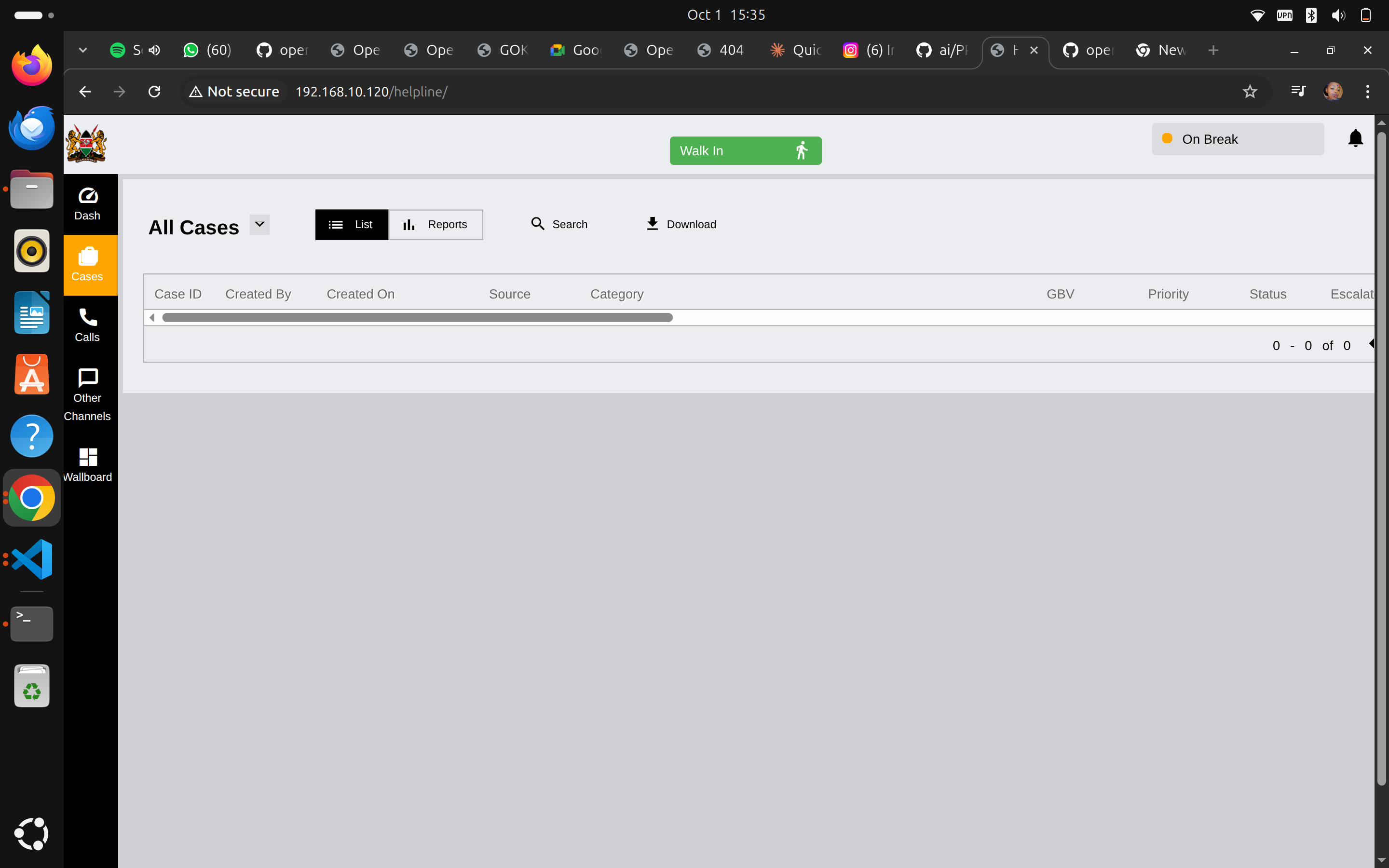Team Workflow Management for Supervisors
Guide to monitoring real-time operations, managing staff, and ensuring optimal helpline coverage.
Real-Time Operations Monitoring
Accessing the Wallboard

Navigation: Click "Wallboard" in the left sidebar
What Is the Wallboard?
A real-time display showing current counsellor activity, call queue status, and team performance metrics.
Counsellors Online Section
Displays:
- Number of counsellors currently online (e.g., "6" counsellors)
- Individual counsellor status
- Call handling metrics
- Real-time activity
Table Columns:
- Ext. - Extension number
- Name - Counsellor name
- Caller - Current caller number (if on call)
- Answered - Total calls answered today
- Missed - Calls missed today
- Talk Time - Current call duration
- Queue Status - Current activity state
- Duration - Time in current status
Understanding Queue Status
Status Indicators:
🟢 OnCall (Green)
- Currently speaking with caller
- Duration shows how long on current call
- Monitor for unusually long calls
🟡 Wrapup (Orange)
- Completing post-call documentation
- Standard time: 2-5 minutes
- Watch for excessive wrapup time
⚪ Available (Gray)
- Ready to receive calls
- Waiting for next caller
- Idle time tracked
Status Colors Help You:
- Quickly identify who's busy
- Spot coverage gaps
- Monitor workload distribution
- Identify potential issues
Calls in Queue Section
Shows:
- Number of callers waiting
- Extension/number waiting for
- Caller phone number
- Wait status (Connected, IVR, etc.)
- Wait duration
Example:
Calls in Queue: 0 ← No one waiting (good!)
Calls in Queue: 3 ← 3 callers waiting (need to monitor)
Calls in Queue: 10 ← High volume (action needed)Monitoring Team Performance
Key Metrics to Watch
Real-Time Indicators:
| Metric | Green | Yellow | Red |
|---|---|---|---|
| Queue Size | 0-2 callers | 3-5 callers | 6+ callers |
| Wrapup Time | ❤️ min | 3-5 min | >5 min |
| Available Counsellors | 3+ available | 1-2 available | 0 available |
| Answered vs Missed | >95% answered | 90-95% answered | <90% answered |
Identifying Issues
Red Flags:
- Multiple counsellors on long calls simultaneously
- Consistently high missed call rates for one counsellor
- Extended wrapup times (>5 minutes repeatedly)
- No available counsellors during busy periods
- Growing call queue
Immediate Actions:
- Contact counsellor if issue is urgent
- Reassign tasks if someone needs backup
- Bring additional staff online if available
- Document patterns for staffing adjustments
Throughout the Day
Morning (Shift Start):
- Verify all scheduled staff are online
- Check extension assignments
- Review any handover notes from previous shift
- Brief team on priorities for the day
Mid-Day:
- Monitor queue levels during lunch breaks
- Ensure staggered breaks for coverage
- Check in with counsellors handling difficult cases
- Address any emerging issues
End of Day:
- Review day's metrics
- Note any incidents or concerns
- Prepare handover for next shift
- Ensure all counsellors complete documentation
Managing Staff
User Management

Navigation: Click "Users" in the sidebar (Admin access required)
User List Overview
Information Displayed:
- Username - Login ID
- First Name & Last Name - Full name
- Phone - Contact number
- Email - Email address
- Extension - Phone system extension
- Role - Permission level
- Is Active - Account status (Yes/No)
- Created On - When account was created
User Roles

Available Roles:
- Counsellor - Frontline operators
- Supervisor - Team leads (you)
- Case Manager - Case oversight
- Case Worker - Field staff
- Partner - External organization access
- Media Account - Communications team
- Administrator - System admin (full access)
Role Determines:
- What they can see
- What they can edit
- Who they can manage
- Reports they can access
Creating New User Accounts
When You Need To:
- New hire onboarding
- Temporary staff for busy periods
- Replacement for departed staff
- Role changes/promotions
Steps:
- Click "+ New" button (top right)
- Fill in user information:
- Username (unique, no spaces)
- First and Last Name
- Phone number
- Email address
- Extension number
- Role (select appropriate level)
- Set temporary password
- Mark as Active
- Save
New User Checklist:
- [ ] Account created
- [ ] Login credentials sent securely
- [ ] Extension configured in phone system
- [ ] Added to team schedule
- [ ] Training completed
- [ ] Shadow shift completed
- [ ] First solo shift observed
Editing User Accounts
Common Updates:
- Change extension number
- Update contact information
- Modify role/permissions
- Activate/deactivate account
- Reset password
To Edit:
- Click on user in the list
- Modify necessary fields
- Save changes
- Notify user of any changes
Deactivating Users
When Staff Leave:
- Open their user profile
- Set "Is Active" to "No"
- Save changes
- User can no longer log in
- Their data remains in system for records
Important: Don't delete users - deactivate them. This preserves:
- Case history
- QA records
- Performance data
- Audit trails
Staff Scheduling
Coverage Requirements
Minimum Staffing Levels:
- Peak hours (10am-6pm): 4-6 counsellors
- Off-peak hours: 2-3 counsellors
- Night shift: 1-2 counsellors (if 24/7)
- Always have supervisor available
Considerations:
- Call volume patterns
- Day of week (weekends may differ)
- Special events or campaigns
- Staff experience levels (mix experienced with new)
Creating Schedules
Best Practices:
- Post schedule 2 weeks in advance
- Rotate shifts fairly
- Consider counsellor preferences
- Plan for breaks and lunch
- Build in overlap for handovers
- Have backup staff identified
Schedule Format Example:
Monday, Oct 2:
8am-4pm: Maria (Ext 187), John (Ext 144)
12pm-8pm: Sarah (Ext 133), Lyn (Ext 239)
Supervisor: You (Ext 250)Managing Time Off
Approval Process:
- Counsellor requests time off
- Check schedule coverage
- Approve if adequate coverage
- Update schedule
- Notify team of changes
Balance:
- Staff wellbeing (approve reasonable requests)
- Service needs (maintain coverage)
- Fairness (equal opportunity for time off)
Handling Escalations
When Counsellors Need Help
Common Escalation Scenarios:
- High-risk case (immediate danger)
- Uncertain how to proceed
- Difficult or abusive caller
- Technical system issues
- Personal crisis during shift
How Counsellors Reach You
Methods:
- Internal messaging/chat
- Phone extension
- Emergency button (for urgent situations)
- In-person (if on-site)
Response Time Expectations:
- Emergency: Immediate (within 1 minute)
- High priority: Within 5 minutes
- Standard questions: Within 15 minutes
Responding to Escalations
Step 1: Assess Urgency
- Is child in immediate danger? → Call emergency services
- Does counsellor need immediate help? → Drop everything
- Can it wait 5 minutes? → Finish current task first
Step 2: Take Action
- Listen to counsellor's concern
- Review case if needed
- Provide clear guidance
- Take over call if necessary
- Document the escalation
Step 3: Follow Up
- Debrief with counsellor after
- Check if they need support
- Update case notes
- Report to management if needed
Supporting Staff Wellbeing
Recognizing Stress and Burnout
Warning Signs:
- Increased absenteeism
- Declining QA scores
- Short temper or irritability
- Disengagement from team
- Rushing through calls
- Mistakes in documentation
Causes of Stress:
- High call volume
- Difficult cases (abuse, death)
- Feeling helpless
- Lack of support
- Poor work-life balance
Providing Support
Daily Support:
- Check in with each counsellor
- Encourage breaks
- Create safe space to debrief
- Acknowledge difficult calls
- Celebrate successes
Structured Support:
- Regular one-on-ones (bi-weekly minimum)
- Team meetings (weekly)
- Debriefing sessions after traumatic cases
- Access to counseling services
- Team building activities
When to Refer for Professional Help:
- Persistent symptoms of depression or anxiety
- Significant changes in behavior
- Talk of harming self or others
- Inability to function at work
- Substance abuse signs
Team Meetings and Communication
Weekly Team Meetings
Agenda Template:
Metrics Review (10 min)
- Call volumes
- QA scores
- Team achievements
Case Discussions (15 min)
- Complex cases
- Learning opportunities
- Protocol updates
Team Updates (10 min)
- Schedule changes
- New policies
- Training opportunities
Open Discussion (15 min)
- Concerns or questions
- Suggestions for improvement
- Peer recognition
Best Practices:
- Start and end on time
- Create safe space for honest discussion
- Encourage participation from all
- Follow up on action items
- Rotate note-taking responsibility
Daily Huddles
Quick 10-Minute Stand-Up:
- Any high-priority cases to watch
- Staffing or coverage issues
- Quick wins to celebrate
- Questions or concerns
When: Start of each shift
Communication Channels
For Urgent Issues:
- Phone/extension
- Emergency alerts
- In-person
For Non-Urgent:
- Team chat/messaging
- Email for documentation
- Staff bulletin board
Managing Different Channels
Phone Calls (Primary Channel)
Monitoring:
- Real-time wallboard tracking
- Call duration alerts
- Missed call reports
- Peak time analysis
Optimization:
- Adjust staffing to call patterns
- Route calls efficiently
- Minimize hold times
- Ensure adequate coverage
Other Channels

Navigation: Click "Other Channels" in sidebar
Available Channels:
- SMS/Text messages
- Email inquiries
- Social Media (Facebook, WhatsApp)
- Chatbot interactions
Your Role:
- Monitor response times
- Ensure channel coverage
- Track channel-specific metrics
- Escalate technical issues
Assignment Strategy:
- Dedicated staff for each channel (if volume justifies)
- Or rotation system where counsellors cover multiple channels
- Always have backup coverage
Performance Management
Setting Expectations
Clear Standards For:
- Response times (answer within X rings)
- Case documentation (complete within 24 hours)
- QA scores (minimum 80%)
- Attendance and punctuality
- Professional conduct
Communicate Standards:
- During onboarding
- In writing (handbook)
- Regular reminders
- Performance reviews
Tracking Individual Performance
Key Metrics Per Counsellor:
- Calls handled (quantity)
- Average handling time
- QA scores (quality)
- Missed call rate
- Case completion rate
- Attendance record
Review Frequency:
- Informal check-ins: Weekly
- Formal one-on-ones: Bi-weekly
- Performance reviews: Quarterly
- Annual comprehensive review
Addressing Performance Issues
Early Intervention:
- Notice the pattern
- Discuss with counsellor privately
- Understand root cause
- Create improvement plan
- Set clear timeline
- Provide support and resources
- Follow up regularly
Performance Improvement Plan (PIP):
- Specific issues identified
- Measurable goals set
- Timeline for improvement (typically 30-60 days)
- Regular check-ins scheduled
- Consequences if no improvement
- Documentation of all steps
Progressive Discipline (if needed):
- Verbal warning (documented)
- Written warning
- Final warning
- Termination (following HR policies)
Recognizing Excellence
Ways to Recognize:
- Public praise in team meetings
- Private thank you notes
- Employee of the month
- Small rewards/gift cards
- Professional development opportunities
- Recommendation letters
What to Recognize:
- High QA scores
- Going above and beyond
- Helping team members
- Creative problem-solving
- Positive client feedback
- Consistent reliability
Shift Handovers
Effective Handovers
Information to Share:
- Current queue status
- High-priority cases in progress
- System issues or outages
- Staffing changes for next shift
- Any urgent follow-ups needed
Handover Format:
Date: Oct 1, 2025
Outgoing Shift: 8am-4pm
Incoming Shift: 4pm-12am
Status:
- 6 counsellors online
- 2 calls in queue
- All systems operational
High Priority Cases:
- Case #12345: 10yo girl, possible abuse, police report filed,
follow-up call scheduled for 6pm today
- Case #12346: Suicidal teen, referred to crisis center,
awaiting confirmation
Notes:
- Network was slow 2-3pm, resolved
- Maria (Ext 187) handling difficult case, may need support
- John (Ext 144) leaving early at 3pm for appointment
Next Shift Lead: SarahDocumentation
Where to Document:
- Shift log (shared document)
- Handover sheet (physical or digital)
- Team chat channel
- Email to next supervisor
Keep It:
- Brief but complete
- Organized and clear
- Accessible to next shift
- Updated throughout shift
Crisis Management
Types of Crises
Operational Crises:
- System outage
- Phone system down
- Understaffing (call-outs)
- Overwhelming call volume
Individual Crises:
- Counsellor experiencing personal emergency
- High-risk case requiring immediate action
- Workplace safety issue
- Threat to staff
Crisis Response
Immediate Actions:
- Assess situation severity
- Ensure safety first (staff and callers)
- Implement contingency plan
- Communicate clearly with team
- Escalate to management if needed
- Document everything
Communication During Crisis:
- Brief, clear updates
- Multiple channels (don't rely on system that's down)
- Reassure staff
- Provide clear instructions
- Follow up frequently
After Crisis:
- Debrief with team
- Document lessons learned
- Update contingency plans
- Provide support to affected staff
- Report to management
Contingency Planning
Common Scenarios and Plans
System Outage:
- Manual call logging procedures
- Paper backup forms ready
- IT contact information accessible
- Communication plan for team
- Enter data when system returns
Understaffing:
- On-call backup staff list
- Cross-trained supervisors can take calls
- Prioritize critical cases
- Adjust service hours if needed
- Communicate with callers about delays
High Volume:
- Bring in additional staff
- Extend shifts (if possible)
- Implement overflow procedures
- Prioritize by urgency
- Consider callback system
Power Outage:
- Backup location identified
- Mobile phones as backup
- Generator (if available)
- Remote work options
- Rescheduling protocol
Reporting to Management
Regular Reports
Weekly Summary:
- Call volume statistics
- Staffing levels
- Key incidents
- Training completed
- Issues requiring attention
Monthly Report:
- Team performance metrics
- QA summary
- Cases handled by category
- Staff attendance
- Training needs
- Budget implications
Quarterly Review:
- Trend analysis
- Goal achievement
- Team development
- Process improvements
- Strategic recommendations
Ad-Hoc Reporting
Report Immediately:
- Serious safety incidents
- Data breaches or security issues
- Staff misconduct
- Major system failures
- Media inquiries
- Legal concerns
Quick Reference
Daily Supervisor Tasks
Start of Day:
- [ ] Check wallboard - all staff online?
- [ ] Review handover notes
- [ ] Check for urgent cases
- [ ] Brief team on priorities
Throughout Day:
- [ ] Monitor wallboard regularly
- [ ] Respond to escalations
- [ ] Support counsellors
- [ ] Track metrics
End of Day:
- [ ] Complete shift log
- [ ] Prepare handover
- [ ] Document incidents
- [ ] Review tomorrow's schedule
Key Performance Indicators
| Metric | Target | Alert If |
|---|---|---|
| Queue Size | 0-2 | >5 callers |
| Answer Rate | >95% | <90% |
| Avg Wrapup Time | ❤️ min | >5 min |
| QA Score | >85% | <80% |
| Staff Utilization | 70-85% | <60% or >90% |
Tools and Resources
System Access:
- Wallboard for real-time monitoring
- User management for staff administration
- QA system for quality reviews
- Reporting dashboards for analytics
Documents:
- Staff handbook
- Emergency procedures
- Contact lists
- Training materials
- Performance templates
Support:
- IT help desk
- HR department
- Management team
- UNICEF mentors
Getting Help
Operational Issues:
- IT support for technical problems
- Management for policy questions
- HR for personnel issues
Professional Development:
- Supervisor training programs
- Peer supervisor network
- Industry conferences
- Online resources
Next Steps
- Quality Assurance Monitoring - Conduct effective QA reviews
- Reporting Dashboards - Analyze team performance data
Remember: Your role is to enable your team to do their best work. Support them, guide them, protect them, and celebrate them. A strong supervisor creates a strong team, and a strong team saves lives.